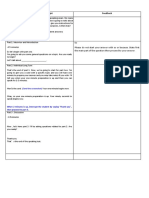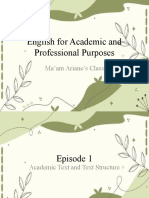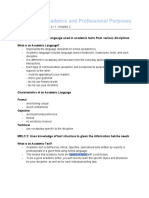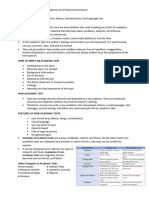To Be Written
To Be Written
Uploaded by
Mary Jane PobleteCopyright:
Available Formats
To Be Written
To Be Written
Uploaded by
Mary Jane PobleteOriginal Title
Copyright
Available Formats
Share this document
Did you find this document useful?
Is this content inappropriate?
Copyright:
Available Formats
To Be Written
To Be Written
Uploaded by
Mary Jane PobleteCopyright:
Available Formats
LESSON ONE:
WHAT IS ACADEMIC TEXT?
Academic text is defined as critical, objective, specialized texts written by experts or professionals in a
given field using formal language.
An academic text is a written language that provides information, which contain ideas and concepts that
are related to the particular discipline. Essay, Literary analysis, Research Paper, Report, Project, Article,
Thesis, and Dissertation are considered as academic texts.
Nature and Characteristics of an Academic Text
1. STRUCTURE- the basic structure that is used by an academic text is consist of three (3) parts-
essay structure (introduction, body, and conclusion) and the IMRAD structure which is formal
and logical. This kind of structure enables the reader to follow the argument and navigate the
text.
STUCTURE OF ACADEMIC TEXT
The three-part essay structure is a basic structure that consists of introduction, body and conclusion.
The introduction and the conclusion should be shorter than the body of the text.
Introduction. Its purpose is to clearly tell the reader the topic, purpose and structure of the paper.
As a rough guide, an introduction might be between 10 and 20 percent of the length of the whole
paper and has three main parts:
A. The most general information, such as background and/or definitions.
B. The core of the introduction, where you show the overall topic, purpose, your point of
view, hypotheses and/or research questions (depending on what kind of paper it is).
C. The most specific information, describing the scope and structure of your paper.
The Body. It develops the question, “What is the topic about?”. It may elaborate directly on the
topic sentence by giving definitions, classifications, explanations, contrasts, examples and evidence.
This is considered as the heart of the essay because it expounds the specific ideas for the readers to
have a better understanding of the topic. It usually is the largest part of the essay.
Conclusion. The conclusion is closely related to the introduction and is often described as its ‘mirror
image’. The conclusion usually begins by briefly summarizing the main scope or structure of the paper,
confirms the topic that was given in the introduction, ends with a more general statement about how
this topic relates to its context.
The IMRaD Structure
The sections of the IMRaD structure are Introduction, Methods, Results and Discussion.
Introduction usually depicts the background of the topic and the central focus of the study.
Methodology lets your readers know your data collection methods, research instrument
employed, sample size and so on.
Results and Discussion states the brief summary of the key findings or the results of your
study.
2. TONE- This refers to the attitude conveyed in a piece of writing. The arguments of others are
fairly presented and with an appropriate narrative tone.
3. LANGUAGE- Clear topic sentences enable a reader to follow your line of thinking without
difficulty. Formal language and the third person point of-view should be used.
4. CITATION- Citing sources in the body of the paper and providing a list of references as either
footnotes or endnotes is a very important aspect of an academic text.
5. COMPLEXITY- An academic text addresses complex issues that require higher-order thinking
skills to comprehend.
6. EVIDENCE-BASED ARGUMENTS- What is valued in an academic text is that opinions are
based on a sound understanding of the pertinent body of knowledge and academic debates
that exist within, and often external to a specific discipline.
7. THESIS-DRIVEN- The starting point of an academic text is a particular perspective, idea or
position applied to the chosen research problem, such as establishing, proving, or disproving
solutions to the questions posed for the topic.
LESSON TWO:
What is an Academic Language?
Academic language represents the language demands of school (academics). Academic
language includes language used in textbooks, in classrooms, on tests, and in each discipline. It is
different in vocabulary and structure from the everyday spoken English of social interactions. Each
type of communication (both academic and social) has its purpose, and neither is superior to the
other.
Academic writing is generally quite formal, objective (impersonal) and technical as illustrated in the
diagram below.
It is formal by avoiding casual or conversational language, such as contractions or informal
vocabulary.
It is impersonal and objective by avoiding direct reference to people or feelings, and instead
emphasizing objects, facts and ideas.
It is technical by using vocabulary specific to the discipline.
You might also like
- Penny Urs 77 Tips For Teaching VocabularyDocument113 pagesPenny Urs 77 Tips For Teaching VocabularyvietdungnhuthaoNo ratings yet
- IELTS Speaking Test ScriptDocument2 pagesIELTS Speaking Test Scriptlara100% (1)
- Learn Biblical Hebrew by John H. DobsonDocument391 pagesLearn Biblical Hebrew by John H. DobsonHappy Home100% (1)
- English For Academic and Professional PurposesDocument12 pagesEnglish For Academic and Professional Purposesmary rose mendoza100% (2)
- 1874 Samaritan Targum PDFDocument275 pages1874 Samaritan Targum PDFSalvador Llorens Señer- Pastor Guillem.67% (3)
- Unit 1 - WritingDocument10 pagesUnit 1 - WritingAndrew Wu100% (3)
- What Is Academic WritingDocument3 pagesWhat Is Academic Writingkeane reyesNo ratings yet
- EAPP Lesson 1Document17 pagesEAPP Lesson 1نجشو گحوشNo ratings yet
- Eapp PPT Leson 1Document23 pagesEapp PPT Leson 1Margie Fernandez100% (1)
- Reading Text in Eapp Week 1 What Is It: Examples of Academic WritingDocument2 pagesReading Text in Eapp Week 1 What Is It: Examples of Academic WritingMaryjoy PerdigonesNo ratings yet
- Perpetual Succour Academy, Inc.: National RD., Poblacion Dos, Malabuyoc, CebuDocument3 pagesPerpetual Succour Academy, Inc.: National RD., Poblacion Dos, Malabuyoc, CebuKen FerrolinoNo ratings yet
- Lesson 1 Academic Text Structures StudentsDocument2 pagesLesson 1 Academic Text Structures StudentsLucia BontilaoNo ratings yet
- Academic Text StructuresDocument2 pagesAcademic Text StructuresaizaNo ratings yet
- Lesson 1Document48 pagesLesson 1Ariane Jeanice Abiada100% (1)
- English For Academic and Professional Purposes Module 1Document11 pagesEnglish For Academic and Professional Purposes Module 1Irene TapangNo ratings yet
- Student's Learning Activity in ENGLISH FOR ACADEMIC and Professional PurposesDocument6 pagesStudent's Learning Activity in ENGLISH FOR ACADEMIC and Professional PurposesJieza May MarquezNo ratings yet
- EAPP - Academic TextDocument2 pagesEAPP - Academic TextRhean Reyle VelardeNo ratings yet
- Eng For AcadsDocument20 pagesEng For AcadsNatalie BuduanNo ratings yet
- Eapp Q1 Module 2Document12 pagesEapp Q1 Module 2Redmond TejadaNo ratings yet
- English For Academic and Professional Purposes (EAPP) Q1/Q3-Module 2 Academic Text StructureDocument11 pagesEnglish For Academic and Professional Purposes (EAPP) Q1/Q3-Module 2 Academic Text Structuremariiah100% (1)
- EAPP ReviewerDocument9 pagesEAPP ReviewerlantakadominicNo ratings yet
- Eapp M1, WK1Document48 pagesEapp M1, WK1Shiela DimayugaNo ratings yet
- English For Academic and Professional PurposesDocument82 pagesEnglish For Academic and Professional PurposesClare SiplonNo ratings yet
- Reviewer EappDocument8 pagesReviewer EappKathleen DcaaNo ratings yet
- l01 Structure of Academic TextDocument4 pagesl01 Structure of Academic TextDanniella LuaresNo ratings yet
- EAPP11 Module 1Document15 pagesEAPP11 Module 1Gwyn LapinidNo ratings yet
- EAPP Lesson 1Document11 pagesEAPP Lesson 1Genie Sina-on DadeaNo ratings yet
- Q3 Week1 EappDocument4 pagesQ3 Week1 EappLyka Christine AlbinaNo ratings yet
- EAPP Q1 Mod1 Reading and Wriitng Academic Text Week1 4Document64 pagesEAPP Q1 Mod1 Reading and Wriitng Academic Text Week1 4Ronn Michael RosarioNo ratings yet
- Lesson 1 Eapp 12Document7 pagesLesson 1 Eapp 12Claudia BanicoNo ratings yet
- EAPP - Lesson 1Document18 pagesEAPP - Lesson 1Ma. Fatima ElamparoNo ratings yet
- Eapp Module 2Document7 pagesEapp Module 2Aster JadeNo ratings yet
- EAPPPPDocument10 pagesEAPPPPAngiela PaulinoNo ratings yet
- Q1. W1. Academic Writing and Types of Text StructureDocument5 pagesQ1. W1. Academic Writing and Types of Text StructureNatsumiGraceNo ratings yet
- These Are The Common Structures of ACADEMIC TEXTDocument2 pagesThese Are The Common Structures of ACADEMIC TEXTMarilyn PadojinogNo ratings yet
- English For Academic and Professional Purposes 1Document3 pagesEnglish For Academic and Professional Purposes 1evafe.campanadoNo ratings yet
- Lesson 1Document13 pagesLesson 1Rey Ann RubioNo ratings yet
- EAPP Quarter 1 Week 1Document19 pagesEAPP Quarter 1 Week 1MARLA RUBY PAZ YTING100% (1)
- EAPP Module Lesson 1Document9 pagesEAPP Module Lesson 1hrmt LabNo ratings yet
- EAPP NotesDocument7 pagesEAPP NotesHANNAH KATRINA DE JESUSNo ratings yet
- Academic TextDocument15 pagesAcademic TextLyssa LimNo ratings yet
- EAPP MIDTERM REVIEWER Page 6-7Document6 pagesEAPP MIDTERM REVIEWER Page 6-7Kate JavierNo ratings yet
- EAPP PresentationDocument14 pagesEAPP PresentationEcent MollionNo ratings yet
- English For Academic and Professional Purposes CM 1Document13 pagesEnglish For Academic and Professional Purposes CM 1afunabermudezNo ratings yet
- G-12 Language Used in Academic Texts From Various DisciplinesDocument7 pagesG-12 Language Used in Academic Texts From Various DisciplinesShirley D. Capili LptNo ratings yet
- Notes 1stquarter EAPPDocument11 pagesNotes 1stquarter EAPPCortez, Keith MarianeNo ratings yet
- English For Academic Teachers Made 1-3Document51 pagesEnglish For Academic Teachers Made 1-3Ken FerrolinoNo ratings yet
- Academic TextDocument32 pagesAcademic TextAngelica Dyan MendozaNo ratings yet
- EAPPDocument14 pagesEAPPLyssa LimNo ratings yet
- Week 1 Eapp Academic TextDocument14 pagesWeek 1 Eapp Academic TextMA. luisa ECHANONo ratings yet
- Academic Text StructuresDocument22 pagesAcademic Text StructuresAngelica Dyan MendozaNo ratings yet
- English For Academic and Professional Purposes: Quarter 1 - Module 1 (Week 1)Document11 pagesEnglish For Academic and Professional Purposes: Quarter 1 - Module 1 (Week 1)FCI Isabela SHSNo ratings yet
- Eapp Module 1Document6 pagesEapp Module 1Benson CornejaNo ratings yet
- Research Sources: Examines, Evaluates, and Makes An ArgumentDocument3 pagesResearch Sources: Examines, Evaluates, and Makes An ArgumentyapitesyaNo ratings yet
- EAPP ReviewerDocument17 pagesEAPP ReviewerkimviaNo ratings yet
- Structure of Academic TextDocument2 pagesStructure of Academic TextAnne Nicole D. TanNo ratings yet
- UcspDocument7 pagesUcspLuke Daniel G. MacasNo ratings yet
- Understanding Culture Society and PoliticsDocument3 pagesUnderstanding Culture Society and PoliticsYane TimaNo ratings yet
- Week1 220904124617 23dc4429Document23 pagesWeek1 220904124617 23dc4429EVA MAE BONGHANOYNo ratings yet
- Eapp Resource Material For Review Quarter 1 Lesson 1 7Document15 pagesEapp Resource Material For Review Quarter 1 Lesson 1 7Jheo TerciasNo ratings yet
- Eapp ReviewerDocument7 pagesEapp Reviewernashevangelista822No ratings yet
- EAPP01Document41 pagesEAPP01angelica peregrinoNo ratings yet
- Northwestern University: Basic Education DepartmentDocument4 pagesNorthwestern University: Basic Education DepartmentZsazsaNo ratings yet
- Understanding Essay Writing: A Guide To Writing Essays By Someone Who Grades ThemFrom EverandUnderstanding Essay Writing: A Guide To Writing Essays By Someone Who Grades ThemRating: 4 out of 5 stars4/5 (4)
- Semantics مذكرهDocument24 pagesSemantics مذكرهM ANo ratings yet
- Slang - Grammar RulesDocument11 pagesSlang - Grammar RulesDajana RakićNo ratings yet
- 2.1 Developing A Standard Method (Abbreviations and Symbols)Document3 pages2.1 Developing A Standard Method (Abbreviations and Symbols)meirinNo ratings yet
- Form 3.2AP - LDM2 Practicum Portfolio - Individual Report of LDM2 Rating of TeachersDocument9 pagesForm 3.2AP - LDM2 Practicum Portfolio - Individual Report of LDM2 Rating of TeachersEmmz Reyes SanchezNo ratings yet
- !project 1-Job Application PackageDocument2 pages!project 1-Job Application PackageJeffrey StrachanNo ratings yet
- 2 Quick Test: Grammar Tick ( ) A, B, or C To Complete The SentencesDocument3 pages2 Quick Test: Grammar Tick ( ) A, B, or C To Complete The SentencesWitman Witman Campos GarayNo ratings yet
- Fa 4 Fluency Time 4Document2 pagesFa 4 Fluency Time 4dothingan2380No ratings yet
- gw3 Past Simple and Past ContinuousDocument3 pagesgw3 Past Simple and Past Continuousapi-317398821No ratings yet
- Examen de Fonetica.Document3 pagesExamen de Fonetica.Alex Ruiz BrionesNo ratings yet
- Arabic Script WorksheetDocument12 pagesArabic Script WorksheetdonkonkeeNo ratings yet
- Ugc Net - English - Free Solved PaperDocument53 pagesUgc Net - English - Free Solved PaperSameen Ahmad Ebaad100% (2)
- VietJetAir Employment Application FormDocument5 pagesVietJetAir Employment Application FormMarawa MohamedNo ratings yet
- ICSE Board Class X English Language Board Paper - 2019 (Two Hours)Document5 pagesICSE Board Class X English Language Board Paper - 2019 (Two Hours)sumon chowdhuryNo ratings yet
- The Poet's Poet by Atkins, ElizabethDocument193 pagesThe Poet's Poet by Atkins, ElizabethGutenberg.org100% (1)
- Social Studies 8th Grade Teacher NotesDocument160 pagesSocial Studies 8th Grade Teacher Notesapi-450759788No ratings yet
- Introduction To SQL Stored ProceduresDocument3 pagesIntroduction To SQL Stored ProceduresbharatkNo ratings yet
- JuliaDocv0 3 5Document537 pagesJuliaDocv0 3 5gastromonoNo ratings yet
- Make + The Particles For, Out and Up: Phrasal Verb MeaningDocument5 pagesMake + The Particles For, Out and Up: Phrasal Verb MeaningAdi Valentin DumitruNo ratings yet
- A Trip To The Sand Castle and MoreDocument47 pagesA Trip To The Sand Castle and MoreDougNewNo ratings yet
- Phonics Workbook Long Vowel PhonemesDocument32 pagesPhonics Workbook Long Vowel PhonemesBruce WayneNo ratings yet
- Border Markets - RJ KloppersDocument27 pagesBorder Markets - RJ Kloppersapi-3750042No ratings yet
- My First Reading Library Parents Guide Uk PDFDocument18 pagesMy First Reading Library Parents Guide Uk PDFĐỗ Trọng Hợp100% (1)
- WhirlpoolDocument2 pagesWhirlpoolJeffrey DavisNo ratings yet
- Ellis.1997.ch 2 and 3Document9 pagesEllis.1997.ch 2 and 3ezıze ehmedovaNo ratings yet
- Autobiography Presentation 1Document9 pagesAutobiography Presentation 1api-606937440No ratings yet

























































































